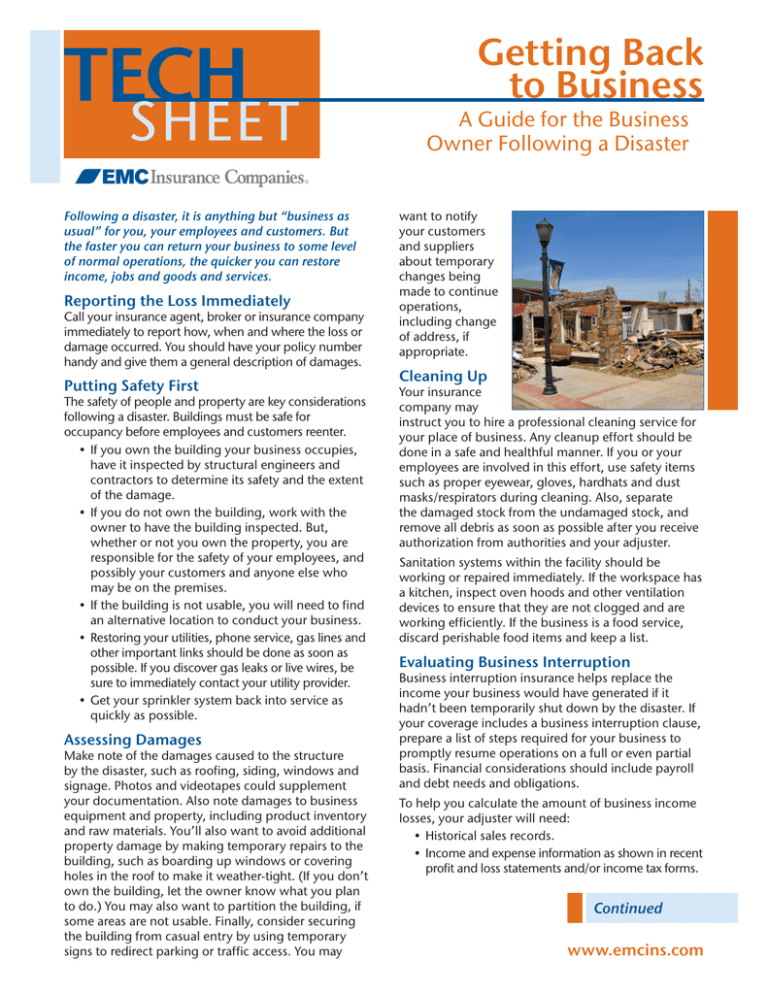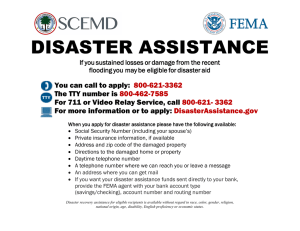
Getting Back
to Business
A Guide for the Business
Owner Following a Disaster
Following a disaster, it is anything but “business as
usual” for you, your employees and customers. But
the faster you can return your business to some level
of normal operations, the quicker you can restore
income, jobs and goods and services.
Reporting the Loss Immediately
Call your insurance agent, broker or insurance company
immediately to report how, when and where the loss or
damage occurred. You should have your policy number
handy and give them a general description of damages.
Putting Safety First
The safety of people and property are key considerations
following a disaster. Buildings must be safe for
occupancy before employees and customers reenter.
• If you own the building your business occupies,
have it inspected by structural engineers and
contractors to determine its safety and the extent
of the damage.
• If you do not own the building, work with the
owner to have the building inspected. But,
whether or not you own the property, you are
responsible for the safety of your employees, and
possibly your customers and anyone else who
may be on the premises.
• If the building is not usable, you will need to find
an alternative location to conduct your business.
• Restoring your utilities, phone service, gas lines and
other important links should be done as soon as
possible. If you discover gas leaks or live wires, be
sure to immediately contact your utility provider.
• Get your sprinkler system back into service as
quickly as possible.
Assessing Damages
Make note of the damages caused to the structure
by the disaster, such as roofing, siding, windows and
signage. Photos and videotapes could supplement
your documentation. Also note damages to business
equipment and property, including product inventory
and raw materials. You’ll also want to avoid additional
property damage by making temporary repairs to the
building, such as boarding up windows or covering
holes in the roof to make it weather-tight. (If you don’t
own the building, let the owner know what you plan
to do.) You may also want to partition the building, if
some areas are not usable. Finally, consider securing
the building from casual entry by using temporary
signs to redirect parking or traffic access. You may
want to notify
your customers
and suppliers
about temporary
changes being
made to continue
operations,
including change
of address, if
appropriate.
Cleaning Up
Your insurance
company may
instruct you to hire a professional cleaning service for
your place of business. Any cleanup effort should be
done in a safe and healthful manner. If you or your
employees are involved in this effort, use safety items
such as proper eyewear, gloves, hardhats and dust
masks/respirators during cleaning. Also, separate
the damaged stock from the undamaged stock, and
remove all debris as soon as possible after you receive
authorization from authorities and your adjuster.
Sanitation systems within the facility should be
working or repaired immediately. If the workspace has
a kitchen, inspect oven hoods and other ventilation
devices to ensure that they are not clogged and are
working efficiently. If the business is a food service,
discard perishable food items and keep a list.
Evaluating Business Interruption
Business interruption insurance helps replace the
income your business would have generated if it
hadn’t been temporarily shut down by the disaster. If
your coverage includes a business interruption clause,
prepare a list of steps required for your business to
promptly resume operations on a full or even partial
basis. Financial considerations should include payroll
and debt needs and obligations.
To help you calculate the amount of business income
losses, your adjuster will need:
• Historical sales records.
• Income and expense information as shown in recent
profit and loss statements and/or income tax forms.
Continued
www.emcins.com
Getting Back to Business
A Guide for the Business Owner Following a Disaster
• Other business records that might assist in
projecting what your profits would have been
if your business had not been interrupted. (You
may need to look to outside resources for these
materials if your paper and computer files were
damaged or destroyed.)
You’ll also want to maintain accurate records of
extra expenses made to expedite the resumption of
operations. Also, keep records of communications
regarding orders to evacuate, including who ordered
the evacuation and the date and time. If portions
of your inventory are lost or damaged beyond
recognition, you’ll need records to evaluate your
loss, such as receipts. Again, if those records are also
lost or damaged, you might want to look at outside
documentation available from your accountant, your
insurance agent or the IRS. It is important that any
shipments received or sales made after the disaster are
documented separately from pre-disaster business.
If you have extra expense coverage, you could be
reimbursed for extra expenses such as continuing
operations at another location, temporarily renting
equipment until damaged equipment can be
replaced, moving expenses, etc.
Returning to Business
The time it takes to return your business to normal
operating levels depends greatly on the decisions you
and your insurance representative make together. The
key decisions may involve these considerations:
• Overall damage assessment.
• Repairs to current location while conducting
business.
• Amount of modifications to current or new
location.
• Reordering inventory, supplies and other
materials.
• Communications with customers, suppliers
and employees.
• Insurance coverage review.
These are some frequently asked questions of
insurance representatives following disasters. You may
want to have this list when you first make contact with
your insurer to avoid multiple follow-up calls:
• What coverage do I presently have?
• Should I make temporary repairs and begin the
cleanup process?
• Who will be my adjuster and when will I be
contacted?
• Should I begin the inventory process, and what is
needed in terms of verification for my claim?
• If I do not have any property damage, but have
lost revenue, can I claim that?
• I had to close my business due to the orders
of civil authorities. Can I make a claim for the
revenue I lost during this time?
Establishing a Disaster Preparedness
Plan for the Future
Emergencies can include natural and man-made
disasters. You will have a better chance of minimizing
employee deaths, injuries and illnesses, reducing
property damage and accelerating business recovery
if you plan ahead. An emergency preparedness plan,
at a minimum, should include the following elements:
• Pre-disaster actions to protect people, facilities
and contents.
• Emergency evacuation procedures and
assignments.
• Essential facility operations (or shutdown)
procedures.
• Off-site storage (backup) of information.
You should discuss your emergency plan with your
employees and provide training and periodic testing of
the plan. Employees should be notified any time changes
are made to the plan. A current copy of the plan should
be kept where employees can refer to it easily.
For Additional Information
The Institute for Business & Home Safety:
www.ibhs.org
American Red Cross: www.redcross.org
Federal Emergency Management Agency:
www.fema.gov
Insurance Information Institute: www.iii.org
U.S. Small Business Administration: www.sba.gov
This material is reprinted with permission from the Institute for Business & Home
Institute: www.ibhs.org
Home Office: 717 Mulberry • Des Moines, IA 50309 • 800-447-2295 • www.emcins.com
Disclaimer: This material is designed and intended for general information purposes only, and is not intended, nor shall be construed or relied upon, as specific legal advice.
©Copyright Employers Mutual Casualty Company 2010. All rights reserved. Image courtesy of FEMA/Win Henderson.
6132 (1-11)




